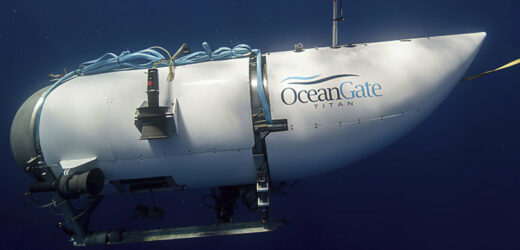Save articles for later
Add articles to your saved list and come back to them any time.
The five people onboard the Titan have been declared dead. For the past three days, the world’s been glued to the story of these men inside the tiny submersible, awaiting their fate. It reminded me of when the world held its breath as the early astronauts endured radio silence on the dark side of the moon or re-entering the earth’s atmosphere. What would become of them?
As a Twitter addict, I’ve had to block all mention of the Titan on that platform over the past few days, as various accounts pumped out macabre speculation.
Some news outlets had an oxygen countdown in their stories, just so you could feel the march to oblivion in real time – is that close enough for you? In any event, it turns out they were all wrong and the sub had imploded almost two hours into the descent.
It’s not just the fact that I’m claustrophobic – getting locked inside a shed as a child has led to a terror of enclosed spaces – but it’s the ghoulish nature of such countdowns; do we really want to imagine the dying moments of another human being while their devastated families on the surface are praying for a miracle?
The loss of the Titan has triggered the debate we had to have around these tragedies, about the public duty to act when a private citizen does something risky. In law, there’s a concept of voluntary assumption of risk; people sign waivers when bungy-jumping to prove they’ve acknowledged the risky nature of the enterprise and therefore can’t sue the operator if anything goes wrong. If SES officers in the course of their work get into trouble, then we willingly spend taxpayer dollars on a rescue. But when wealthy people (let’s face it, they’re almost all men) want to climb high mountains, sail around the world in tiny yachts and strap into moon rockets – just for fun – what’s the public duty when they get into trouble? And who pays for it?
Getting into Elon’s Starship is not equivalent to a similarly dangerous activity – getting on a 787 to London – because commercial flights have stringent safety standards. Titanic director James Cameron, who has done the same dive as the Titan, spoke out this week. He said many players in the deep submergence engineering community were concerned about the fact the Titan’s owners had ignored calls to get it independently checked and certified.
Did the five men on board really appreciate the risk they were taking or did they assume their $US250,000 ($370,000) fee meant that was minimised? No doubt future lawsuits will shine a light on where those lines were drawn, and already there has been speculation about the extent of their knowledge.
Personal injury attorney and maritime law expert Matthew D. Shaffer has said the waiver would be invalid if “there were aspects of the design or construction of this vessel that were kept from the passengers, or it was knowingly operated despite information that it was not suitable for this dive”.
Men have always enjoyed pitting themselves against the elements, but eye-wateringly expensive adventure tourism, where the hazards are part of the thrill, has taken off over the past few decades. It caters to a group with waning testosterone and bulging wallets; in real life, Jeff Bezos is just a 59-year-old white guy who sells things on the internet, but inside his oddly shaped space rocket – he’s a colossus. Climate change has exacerbated the risks here, and as the ice melts on the mountains and extreme weather events increase, so do the chances of dying on a mountain climb or ocean voyage.
Titan passengers (from left): Stockton Rush, Hamish Harding, Paul-Henri Nargeolet, Suleman Dawood and Shazada Dawood.
And what is the role of the media here? Globally, the fate of the crew inside the Titan has been the biggest story for days. It appealed to our desperate desire for a happy ending; in the case of the young boys in the Thai caves, the Chilean miners trapped underground and missing solo yachtsman Tony Bullimore, we got our wish.
The Bullimore rescue in 1997, involving the Royal Australian Navy, cost the Australian taxpayer millions of dollars, which was much commented on at the time. But it’s not just money; a total of 195 people have died climbing Mount Everest since 1922, along with 125 Sherpas. Should the Sherpas, who receive a small percentage of the fee paid by the climbers, risk their lives to drag along a paying customer? What’s the limit of their duty of care?
A week before the Titan went down with five lives, as many as 600 people were presumed dead in the sinking of an overcrowded fishing trawler off the coast of Greece, which received a fraction of the media coverage. How do we weigh up the loss of those 600 lives against the five people in the Titan? It’s a challenging question.
Margot Saville is a journalist and regular columnist.
The Opinion newsletter is a weekly wrap of views that will challenge, champion and inform your own. Sign up here.
Most Viewed in World
From our partners
Source: Read Full Article



